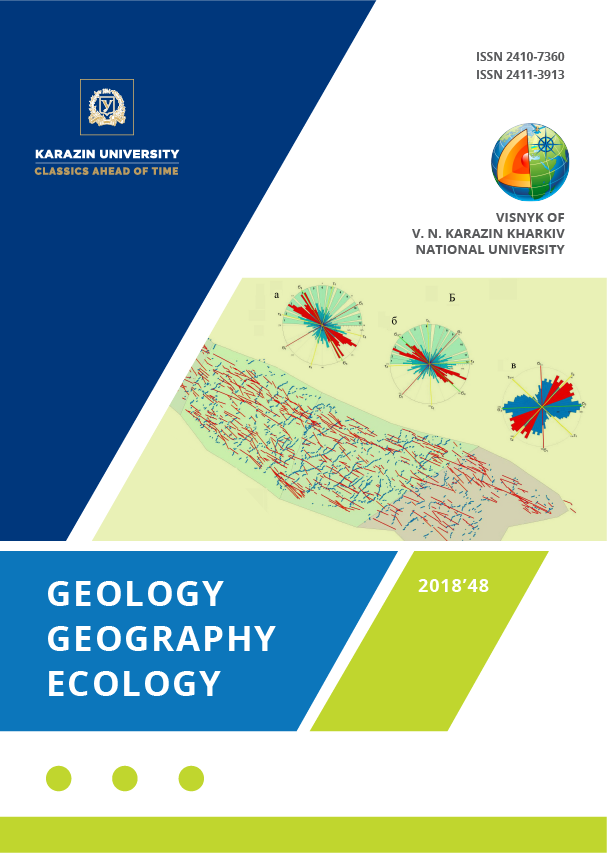Gas-volumetric method in laboratory research practice of rocks collector properties
Abstract
Problem statement. Gas-volumetric method of porosity and density in rocks collectors’ determination is becoming more and more popular in production and educational practice. The theory and practice of this method in the domestic literature is not sufficiently covered, there is a lack of literature on the principles of the obtained results and comparison of gas-volumetric method results with the saturation method, which until now has been the main method for determining porosity and density of rocks.
The purpose of this work is to study gas-volumetric method in – depth, to compare its results with the results of the liquid saturation method, determine the convergence between these methods and the possibility of their interchangeability in the complex of laboratory studies of reservoir properties.
A scientific and practical value is conditioned by the fact that porosity of collectors is a basic calculation parameter. Accuracy of hydrocarbon supply depends on it.
Preliminary analysis of the available material. All available material on the design and operation of gas-volumetric devices were analyzed for this purpose and a simple but sufficiently complete description of the methodology and the operation principle of devices suitable for workers at production laboratories and students undergoing training on these devices was given.
The comparison of the results. Before comparison, the results were checked for convergence on the standards and on the samples. After confirming the performance of the device and its compliance with the specifications stated in its technical passport, we switched to the comparison of different methods. By comparing the results of open porosity, apparent mineralogical density, volumetric density obtained by the gas-volumetric method and saturation with kerosene and water we came to certain conclusions.
The main conclusions are: 1. The scope of exclusive application of the gas-volumetric method is defined. 2. The quantitative correlation of the above parameters on the results of the gas-volumetric method and the saturation method by reservoir water or kerosene is established. 3. The increase in porosity was estimated by the gas-volumetric method. 4. Introduction of correction factors of one method results to the results of another one is proved and their values are preliminarily estimated.
Downloads
References
Gorojan, V. I. (1970). Selection of a rational scheme of a gas-volumetric flow meter for measuring porosity. In col.of papers «Methods of rock-collectors reseach ». Moscow, Tr. VNIGNI, 90, 32-59.
Petersil'e, V. I., Belov, Ju. A. (1974). The methodology for the measurement of porosity and mineralogical density by the compensation obemomer. V sb. «Metody issledovanija porod-kollektorov nefti i gaza i apparatura dlja jetih celej», Moscow, Tr. VNIGNI, 156, 41-47.
Gorojan, V. I. (1974). Compensatory and recurrent method for measuring the volume of the solid phase of the sample. V sb. «Metody issledovanija porod-kollektorov nefti i gaza i apparatura dlja jetih celej» Moscow, Tr. VNIGNI, 156, 59-64.
Guidelines for the study of rock-collector of oil and gas by physical and petrographic methods (1978). M., VNIGNI, 395.
Morozovich, Ja. R., Koposov, I. A., Kulikov, Ju. A. (15.12.75). Sertificate of authorship # 495589 SSSR. Device for measuring the porosity and volume of the skeleton of rock samples. Bjulleten' 46.
Gromov, V. K. (15.08.1976). Sertificate of authorship # 495589, kl. G 01 N 15/18. A method for determining the porosity of solids and a рorosimeter for its implementation.
GOST 26450.0-85 (1985). Rocks. General requirements for sampling and sample preparation for reservoir characterization. M., izd-vo standartov, 8.
GOST 26450.1-85 (1985). Rocks. Method for the determination of open porosity coefficient by fluid saturation. M., Izd-vo standartov, 8.
Nesterenko, M. Iu., Pylyp, Ya. A., Ivanov, V. V., Vikhot, Yu. M. (2011). The determination of open porosity rocks using by a gas-volume method. Naftova i hazova promyslovist, 2, 17-20.
Zijatdinov, I. G. (2016). The latest research methods of core material]. Available at: http://www.tatnipi.ru.
Shnurman, G. A., Bojarchuk, A. F., Brajlovskaja, A. L., Barminskij, M. A., Shipulin, S. V. (1989). Closed porosity of rocks, ways to identify and quantify. Geologija nefti i gaza, 7, 17-19.
Gas-volumetric pycnometer «Poromer». User manual (2014). LTD JekogeosProm, Tver', 9.
Dahnov, A. V., Krjukova, I. B. (2014). To increase the accuracy of determining the coefficient of open porosity by pycnometer «Poromer». Vesti gazovoj nauki, 2, 44-46.
Website guide chemist of the 21st century. Available at: www.chem21.info.
Substantiation of standard values of filtration-capacitive parameters terrigenic reservoir rocks for calculation of total hydrocarbon reserves. Guidelines. (2005). LV UkrDHRI, Kyyv-Lviv, 58.
SOU 09.1-30019775-218:2013 (2013). Core studies of oil and gas wells. The procedure of carrying out. Kyyv, PAT «Ukrhazvydobuannia», 28.
Hanin, A. A. (1969). Rock-collectors of oil and gas and their study. M.: Nedra, 368.
Kotyahov, F. I. (1977). Physics of oil and gas reservoirs. M.: Nedra, 287.
Gimatudinov, Sh. K. (1971). Physics of oil and gas reservoir. M.: Nedra, 312.
Ivanov, M. K., Kalmykov, G. A., Belohin, V. S., Korost, D. V., Hamidullin, R. A. (2008). Petrophysical methods of research of core material. M.: Izd-vo Mosk. un-ta, 113.
Nesterenko, M. Iu., Pylyp, Ya. A., Ivanov, V. V., Vikhot, Yu. M. (2011). Methodological aspects of determining capacity parameters for the rock samples. Naftova i hazova promyslovist, 2, 17-20.
Jan'shina, N. A. (1974). Estimation of mineralogical density of limestone in Western Uzbekistan. V sb. «Metody issledovanija porod-kollektorov nefti i gaza i apparatura dlja jetih celej» Moskva, Tr. VNIGNI, vyp. 156, 27-32.
Gudok, N. S., Bogdanovich, N. N., Martynov, V. G. (2009). Determination of physical properties of oil-containing rocks. Moscow: Nedra, 592.





